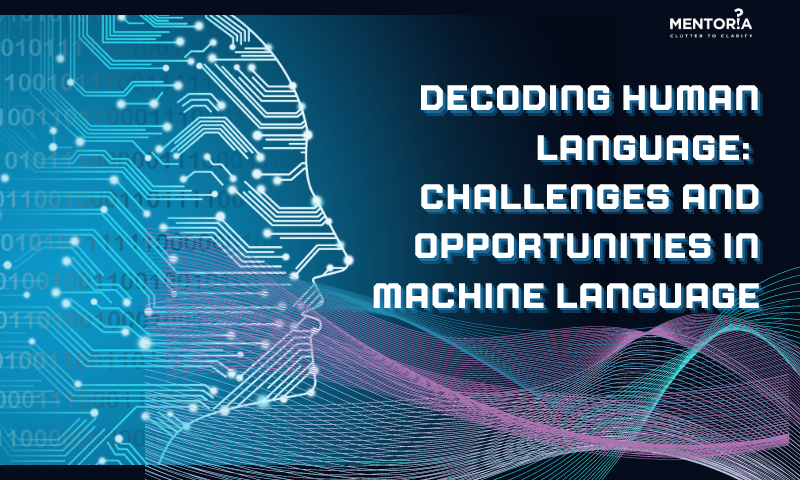Decoding Human Language: Challenges And Opportunities In Machine Language

Did you know that there are over 6,500 spoken languages in the world today? Language is a remarkable gift bestowed upon humanity. It allows us to convey thoughts, share emotions, and express the depths of our imagination. Yet, enabling machines to understand human language is a complex and awe-inspiring endeavour. From voice assistants to language translation tools, the development of natural language processing (NLP) technology has brought us closer to the dream of seamless human-machine communication. However, this journey is not without its challenges. In this blog, we delve into the fascinating world of developing machines that comprehend and respond to human language, exploring the hurdles faced and the boundless opportunities that lie ahead. Get ready to unravel the enchantment of words and witness the transformative power of language technology.
Unleashing The Power Of Language
Imagine a world where machines can understand and respond to our words as effortlessly as humans do. This transformative possibility opens doors to numerous applications, from personal assistants that anticipate our needs to language tutors that adapt to our learning styles. But how do we teach machines to grasp the nuances, subtleties, and vastness of human language? Let’s embark on this journey together!
The Challenge Of Ambiguity
One of the greatest hurdles in developing machines that understand human language lies in tackling the inherent ambiguity present in our communication. Words and phrases often carry multiple meanings, and deciphering the intended sense relies heavily on the context in which they are used. For instance, take the word “bat.” Is it referring to a nocturnal flying mammal or a piece of sports equipment used in baseball? For humans, this disambiguation process seems effortless, but for machines, it poses a significant puzzle.
To address this challenge, researchers and engineers employ sophisticated techniques rooted in natural language processing (NLP) and machine learning. These methods enable machines to analyse the surrounding words, sentences, and broader contexts to extract the most accurate interpretation. By incorporating context-aware algorithms, machines can unravel the mysteries of language and provide more precise and meaningful responses.
Developing robust language models that can effectively handle ambiguity opens up a myriad of possibilities in various applications. From chatbots providing customer support to virtual assistants aiding in daily tasks, accurate understanding of ambiguous language is vital for creating intuitive and human-like interactions. While the challenge of ambiguity persists, ongoing advancements in NLP and machine learning continue to propel us toward machines that comprehend human language with greater clarity and precision.
Context: The Key To Comprehension
Understanding language goes beyond the mere arrangement of words. It requires grasping the context in which those words are used. Context provides vital clues that shape the meaning and intent of our expressions, and machines must learn to utilise this context to achieve accurate language comprehension.
Natural language processing (NLP) techniques play a central role in deciphering context. These techniques allow machines to analyse the surrounding words, phrases, and sentences, uncovering the relationships and dependencies that exist between them. By considering the broader context, machines can disambiguate words, resolve references, and grasp the underlying message more effectively. Context-aware models also enable machines to handle various linguistic phenomena such as anaphora (referring back to previous words), ellipsis (omitting words that can be inferred), and co-reference (referring to the same entity with different expressions). These capabilities enhance the overall language understanding and make interactions with machines feel more natural and seamless.
The Wonders Of Sentiment Analysis
Language carries more than just information; it conveys emotions and sentiments that shape our communication. Sentiment analysis, a branch of natural language processing (NLP), focuses on teaching machines to understand the underlying emotions embedded in text, enabling them to discern whether a statement is positive, negative, or neutral.
Through the analysis of linguistic cues, sentiment analysis algorithms can identify sentiment-bearing words, expressions, and patterns, enabling machines to gauge the overall sentiment of a text accurately. This capability has significant implications in various domains. Companies can monitor customer sentiment on social media, gauging brand perception and responding to customer feedback promptly. Sentiment analysis also aids in the analysis of product reviews, political discourse, and public opinion, providing valuable insights to businesses, policymakers, and researchers.
Beyond Words: Embracing Non-Verbal Communication
Language extends beyond words, encompassing non-verbal cues such as gestures, facial expressions, and tone of voice. To bridge this gap, researchers are exploring multimodal learning, enabling machines to interpret and respond to visual and auditory signals. The ability to detect sarcasm, irony, or humour would be a milestone in developing truly human-like conversational AI.
The Endless Vocabulary Challenge
Human language is ever-evolving, with new words and phrases sprouting constantly. The rapid emergence of slang, jargon, and cultural references poses a formidable challenge for machines. Keeping language models up-to-date is a daunting task, requiring continuous learning from vast amounts of data and staying in sync with cultural shifts. But the rewards are worth it—a machine that speaks our language, figuratively and literally.
Ethical Considerations
As we empower machines with language understanding, ethical dilemmas come into play. Machines can unwittingly perpetuate biases embedded in training data, discriminate, or invade privacy. It is essential to ensure fairness, transparency, and accountability in the development and deployment of language understanding systems, with conscious efforts to mitigate unintended consequences.
As we overcome the challenges of language understanding, a world of possibilities awaits us. Conversational agents will become trusted companions, aiding us in tasks, providing personalised recommendations, and even engaging in philosophical debates. Language barriers will crumble, fostering global communication and understanding. The boundaries of human-machine interaction will blur, ushering in an era of seamless integration.
Unleashing The Potential With Mentoria
The quest to develop machines that understand human language is a testament to the boundless human curiosity and ingenuity. As we conquer the challenges of ambiguity, context, sentiment, and ever-changing vocabulary, we pave the way for transformative advancements in technology. In the pursuit of harnessing the power of human language, Mentoria stands as a guiding light. With their innovative language technologies and expert guidance, they empower individuals and organisations to navigate the evolving landscape of communication. So, let us continue to unravel the magic of words, opening new frontiers of human-machine interaction and shaping a future where communication knows no limits.









